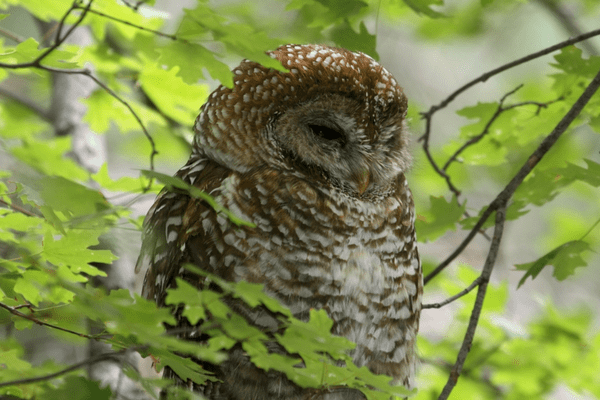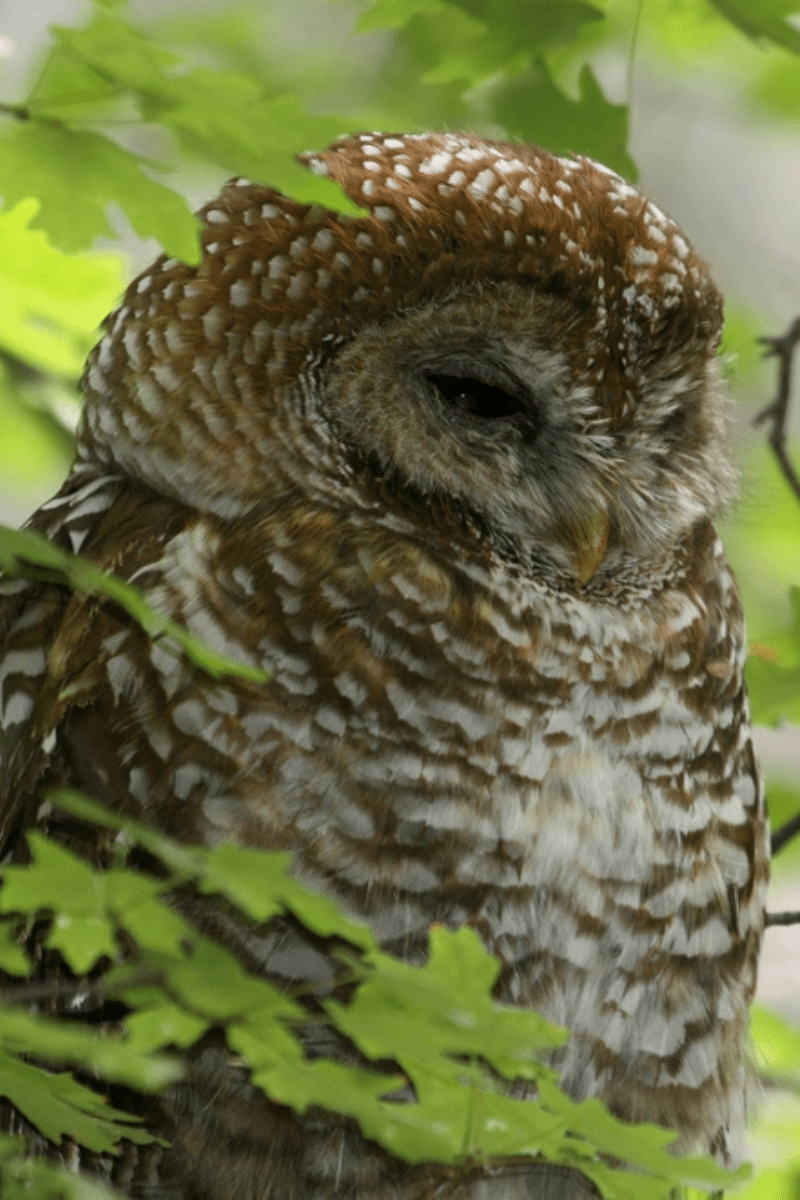Contents
Spotted owls are very popular birds although their overall population numbers are beginning to decrease. They aren’t considered in danger of becoming extinct yet, but there is cause for concern.
There are three specific subspecies of spotted owls. There are northern spotted owls, California spotted owls, and Mexican spotted owls. They remain predominantly in North America in places like California, Washington, Oregon, and Mexico. They are also found in British Columbia as well.
Today, I’d like to teach you many important facts about these beautiful creatures. Other names are Hoot Owl, Brown-Eyed Owl, Wood Owl, Canyon Owl, and Pootie Owl.
Right now, I’d like to cover the following topics below:
- Tips for identifying spotted owls
- Characteristic differences between female and male spotted owls
- Spotted owl fun facts and more
- Different habits and preferences including behavioral, nesting, feeding, and migratory
- Even more interesting facts
Keep reading below to discover everything that I’ve learned.
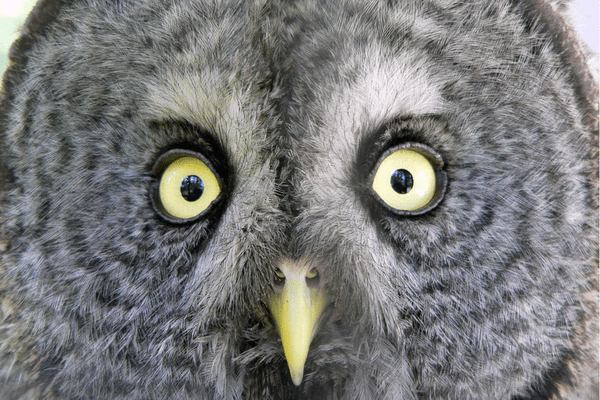
Spotted owl facts
- Common Name: Spotted Owl
- Scientific Name: Strix occidentalis
- Scientific Family: Strigidae
- Life Span: 10 years
- Size: 18.5 to 18.9 inches
- Wingspan: 39.0 to 42.0 inches
- Weight: 17.6 to 24.7 oz
- Conservation status: Near Threatened
Spotted owl: how-to identify
For the most part, spotted owls have dark-brown feathers with a bit of white mixed into the overall color scheme. And on their belly and chest, they are covered with oval white spots that are relatively large. They also have facial discs with pale marks and dark brown feathers that create an X shape between their eyes.
The facial disk on the Mexican spotted owl is much paler than that of its California or Northern counterpart. Also, the spotted owl has dark eyes, as opposed to other owls that often have orange or yellow eyes.
Differences Between Male & Female
Quite commonly, both male and female spotted owls have a very similar-looking plumage, so their feathers maintain a very similar color scheme. The main difference between male and female spotted owls is the difference between most owls. Typically, the females are larger than the males, and in this case, they weigh roughly 10% to 20% more.
Differences In Summer Plumage vs Winter Plumage
It doesn’t appear that the spotted owls’ plumage will change colors during different seasons. They typically stick to their normal climate and territory, which isn’t conducive to feather color changes.
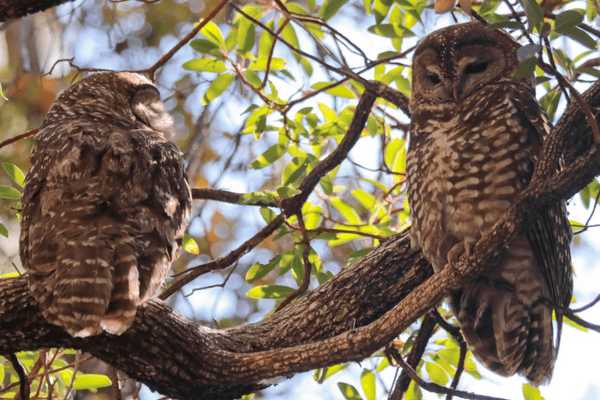
Where You’ll See Spotted Owls
Spotted owls are prominently well represented on the Western coast of the United States of America and British Columbia. It’s easy to spot a wide array of northern spotted owls and California spotted owls in states including Washington, Western Oregon, and Northwestern California.
They like living in old-growth forests. In particular, they enjoy forests with plenty of Douglas for trees. These trees take anywhere from 150-200 years to reach full maturity. They also like the steep canyons and oak woodlands of California in the Southwest.
Spotted owl bird migration
The spotted owl is considered a sedentary bird, so it will remain in the same territory and it does not migrate. On occasion, it will be forced to react to temperature changes or a lack of food, so the owl might move around within its typical territory. But it isn’t going to migrate to another location to move away from a harsh winter or particularly brutal summer.
Spotted owl diet
These owls aren’t creatures that will eat plant food or birdseed. They are predators that hunt down their natural prey. For the most part, the animals that they focus on eating tend to be rodents and other small to medium-sized mammals.
The California spotted owl and northern spotted owl are particularly fond of dusky-footed woodrats and flying squirrels. Even though both of these animal species are limited in number, they tend to be readily available in the wooded areas that both of these types of spotted owls prefer.
The most common prey for spotted owls includes:
- Brush rabbits
- Bats
- Flying Squirrels
- Red-backed voles
- Bushy-tailed woodrats
- Pocket gophers
- Red tree voles
- Snowshoe hares
- Mice
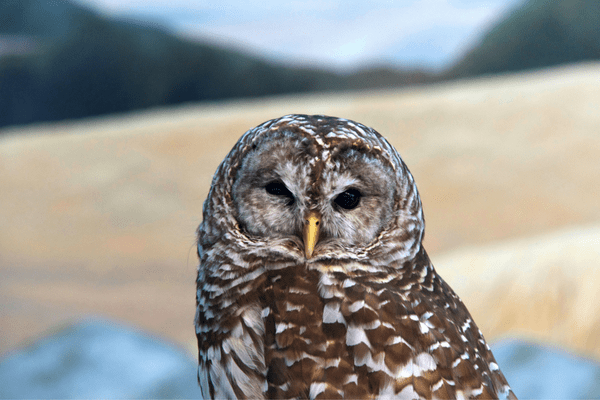
Spotted owl nesting
- Clutch Size: 1-4 eggs
- # of Broods: 1 brood
- Incubation Period: 28-32 days
- Nestling period: 34-36 days
- Egg Description: White, pearl gray
This owl’s nesting site is typically chosen by the male. He will choose a nest in a relatively dense part of the old forest because he wants an area that has a thick tree canopy and something that’s well-protected from the open sky.
More than likely, he’ll pick a nest that was left behind by all or other birds of prey. Or maybe he’ll choose a nest previously occupied by a squirrel. Or another possibility is he’ll take over a hollowed-out tree trunk or broken-off treetop.
The female will prepare the nest by scraping it out, creating a shallow depression. It will also remove some of the debris left at the site. As far as adding to the nest goes, the female doesn’t provide much new material. She may only add a few feathers and nothing more.
Typically, the nest of the northern spotted owl is somewhere in the neighborhood of 15-23 inches. They prefer their nests to be relatively small and minimalist.
Spotted owl behavior
This owl, and in particular, the northern spotted owl, are patient creatures that like to perch and wait to pounce on their prey at night. According to the National Wildlife Federation, this strategy is called “perch-and-pounce.”
The NWF says, “They sit on tree branches at night, using their keen vision to scan for prey in the dark. When a potential meal is spotted, they silently swoop down and capture the prey with their talons.”
Monogamy is also an important part of their life. When a northern spotted owl finds a mate, it will mate with this bird for life.
Although it isn’t the swiftest creature to take flight, it’s very agile and maneuverable nonetheless. It uses quick wing beats interspersed with gliding flight to get from perch to perch. They typically avoid traveling long distances and they usually steer clear of flying above the canopy of the trees.
They move throughout their territory according to temperature changes. This is likely the signifying reason why they prefer living in old-growth forests with multilayered vegetation because it provides ample safety and protection.
These owls remain solitary creatures for most of their lives. The only exception is when they’re interacting with their young or their mate. A pair of mates will typically interact and roost together for 4-6 weeks prior to eggs being laid. And when these owls are roosting together, they will typically preen each other and themselves at the same time.
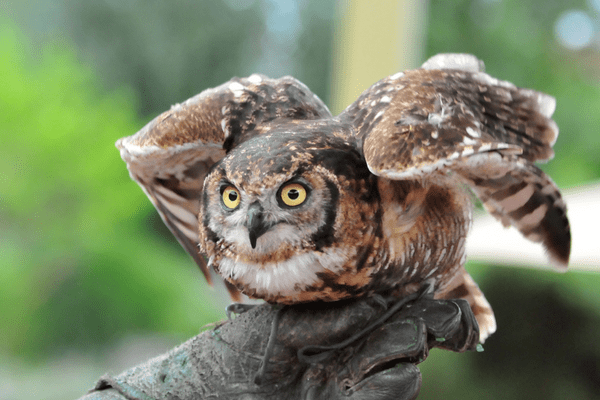
How-to attract spotted owls
These are predators, so their habitat needs to be conducive to catching prey. It also needs to provide adequate shelter and nesting opportunities. Many owls like this prefer to nest inside a mistletoe tangle, the hollow of a tree trunk, or they’ll take over the old nest left by a bird of prey or squirrel.
Attracting these owls doesn’t need to be difficult as long as you have the right type of land. Make sure your land has open skies and trees that spotted owls would like to nest in. The tree doesn’t necessarily have to have a hollow because you can add a nesting box, which the owl will gladly take over because they do not mind living in man-made structures.
Try not to cut the grass too short because these owls are predators and they hunt for small prey. Longer grass means more small predators will be roaming around your backyard including moles, voles, shrews, squirrels, mice, rats, and other rodents.
Installing a large birdbath in your backyard is also a great idea. These birds and other owls for that matter love having a freshwater source available in their territory. In fact, it’s of the utmost importance to their survival. Not only will they use it to drink the water, but they will also bathe in this water and use it to care for their young ones as well.
Spotted owl threats
This owl’s conservation status is currently listed as Near Threatened. According to the Endangered Species Act, the northern spotted owl, California spotted owl, and Mexican spotted owl are all in the midst of a population decrease. The current number of northern spotted owls is 15,000, but this amount is decreasing year after year.
Why is this happening? One of the big problems is that they are experiencing degradation and loss of habitat. Forests and wooded areas are disappearing all throughout North America, which is definitely posing a major problem. The barred owl is also in competition with the spotted owl for territory. Unfortunately, the spotted owl appears to be losing territory to the barred owl, which is also a major reason for the ongoing population decline.
Right now, the number of northern spotted owls is declining at a rate of 2.9% each year. Logging on private lands, barred owl competition leading to less breeding success, and other aggressive species in the West are other chief reasons why their population is declining.
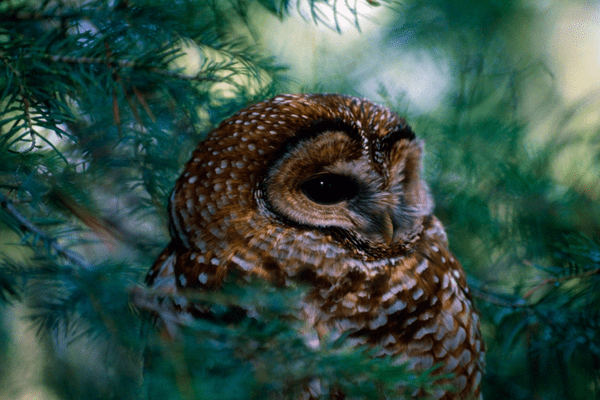
Spotted owl fun & interesting facts
- This owl’s call consists of a series of notes that are four spaces apart and the two notes in the middle remain closest together. It sounds something like “hup, hoo-hoo, hoo.”
- Although this creature lives for about 10 years on average, it can live up to 17 years old in some cases.
- In Canada, northern spotted owls are considered endangered species. The same owl is only considered threatened in the US.
- At two years old, they will reach their sexual maturity. At this time, it will pair off with another spotted owl of the opposite sex and become monogamous for life.
- The survival of the northern spotted owl is negatively impacted by barred owls. They are taking over the territory of the spotted owls, which makes it difficult for them to survive.
- They are capable of capturing their prey in midair. Or they can swoop down and pluck their prey directly from branches. They use their bills to break the necks of their prey.
- When these owls first hatch, their eyes remain closed, they are covered in white down, and they are helpless so their parents must protect them.
- Barred Owl
- Elf Owl
- Northern Hawk Owl
- Short-Eared Owl
- Northern Saw-Whet Owl
- Burrowing Owl
- Northern Pygmy-Owl
- Snowy Owl
- Western Screech-Owl
- Great Gray Owl
- Boreal Owl
- Flammulated Owl
- Eastern Screech-Owl
- Long-Eared Owl

